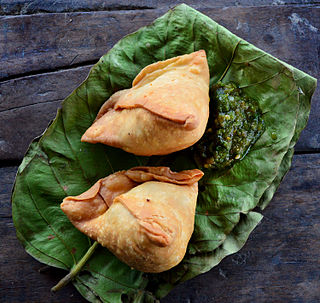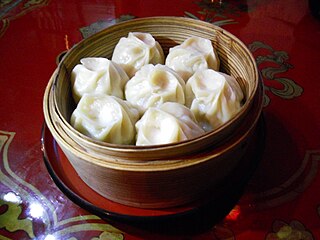Related Research Articles

Shepherd's pie, cottage pie, or in French cuisine hachis Parmentier, is a savoury dish of cooked minced meat topped with mashed potato and baked, formerly also called Sanders or Saunders. The meat used may be either previously cooked or freshly minced. The usual meats are beef or lamb. The terms shepherd's pie and cottage pie have been used interchangeably since they came into use in the late 18th and early 19th centuries, although some writers insist that a shepherd's pie should contain lamb or mutton, and a cottage pie, beef.

A samosa from the Persian word sambosag (سنبوسگ) is a fried South Asian and West Asian snack. It is a pastry with a savory filling, mostly vegetables, spiced potatoes, onions, and peas, but also meat or fish. It is made in different shapes, including triangular, cone, or crescent, depending on the region. Samosas are often accompanied by chutney, and have origins in medieval times or earlier. Sweet versions are also made. Samosas are a popular entrée, appetizer, or snack in the cuisines of India, South Asia, West Asia, Central Asia, Portugal,East Africa and their South Asian diasporas.

Momos are a type of steamed filled dumpling in Tibetan and Nepali cuisine that is also popular in neighbouring Bhutan, Bangladesh, and India. The majority of Tibetan momos are half-moon in shape like jiaozi, while Nepali momos are normally round like baozi. Momos are usually served with a sauce known as achar influenced by the spices and herbs used within many South Asian cuisines. It can also be used in soup, as in jhol momo and mokthuk.

South Asian cuisine includes the traditional cuisines from the modern-day South Asian republics of Bangladesh, India, Maldives, Nepal, Pakistan and Sri Lanka, also sometimes including the kingdom of Bhutan and the emirate of Afghanistan. Also sometimes known as Desi cuisine, it has been influenced by and also has influenced other Asian cuisines beyond the Indian subcontinent.

Thenthuk or hand-pulled noodle soup (thukpa), is a very common noodle soup in Tibetan cuisine, especially in Amdo, Tibet where it is served as dinner and sometimes lunch. The main ingredients are wheat flour dough, mixed vegetables and some pieces of mutton or yak meat. Vegetable thenthuk is a common modern-day option too.

Tibetan cuisine includes the culinary traditions and practices of the Tibetan people in the Tibet region. The cuisine reflects the Tibetan landscape of mountains and plateaus and includes influences from neighbors. It is known for its use of noodles, goat, yak, mutton, dumplings, cheese, butter, yogurt, and soups. Vegetarianism has been debated by religious practitioners since the 11th century but is not prevalent due to the difficulty of growing vegetables, and cultural traditions promoting consumption of meat.
Newa cuisine/नेवा: नसा is a distinctive subset of Nepalese cuisine that has developed over centuries among the Newars of Nepal Mandal in Nepal. Newa cuisine is the most celebrated food variety in the country and consists of over 500 dishes. It is more elaborate than most Nepalese cuisines because the Kathmandu Valley has exceptionally fertile alluvial soil and enough wealthy households to make growing produce more profitable than cultivating rice and other staples.

Nepali cuisine comprises a variety of cuisines based upon ethnicity, alluvial soil and climate relating to cultural diversity and geography of Nepal and neighboring regions of Sikkim and Gorkhaland. Dal-bhat-tarkari is eaten throughout Nepal. Dal is a soup made of lentils and spices, bhat — usually rice but sometimes another grain — and a vegetable curry, tarkari. Condiments are usually small amounts of spicy pickle which can be fresh or fermented, mainly of dried mustard greens and radish and of which there are many varieties. Other accompaniments may be sliced lemon (nibuwa) or lime (kagati) with fresh green chilli and a fried papad and also Islamic food items like rice pudding, sewai, biryani etc. Dhindo (ढिंडो) is a traditional food of Nepal. A typical example of Nepali cuisine is the Chaurasi Byanjan set where bhat (rice) is served in a giant leaf platter (patravali) along with 84 different Nepali dishes each served on small plates. It is mostly fed during weddings and Pasni.

Buuz are a type of Mongolian steamed dumpling filled with meat. An example of authentic Mongolian and Buryatian cuisine, the dish is traditionally eaten at home during Tsagaan Sar, the Lunar New Year. In modern times it is also offered at restaurants and small cafes ("guanz") throughout the capital city of Ulaanbaatar.

Tingmo is a steamed bread in Tibetan cuisine. It is sometimes described as a steamed bun that is similar to Chinese flower rolls, with a soft and fluffy texture. It does not contain any kind of filling. A tingmo with some type of filling, like beef or chicken, is called a momo. Tingmo are often paired with vegetable dishes, meat dishes, dal dishes, and phing sha. It is speculated that the name "tingmo" is a contraction of "tinga" and "momo".

This is a categorically organized list of foods. Food is any substance consumed to provide nutritional support for the body. It is produced either by plants, animals, or fungi, and contains essential nutrients, such as carbohydrates, fats, proteins, vitamins, and minerals. The substance is ingested by an organism and assimilated by the organism's cells in an effort to produce energy, maintain life, or stimulate growth.

Dumplings are a broad class of dishes that consist of pieces of cooked dough, often wrapped around a filling. The dough can be based on bread, wheat or other flours, or potatoes, and it may be filled with meat, fish, tofu, cheese, vegetables, or a combination. Dumplings may be prepared using a variety of cooking methods and are found in many world cuisines.

Jiaozi are a type of Chinese dumpling. Jiaozi typically consist of a ground meat or vegetable filling wrapped into a thinly rolled piece of dough, which is then sealed by pressing the edges together. Jiaozi can be boiled (shuǐjiǎo), steamed (zhēngjiǎo), pan-fried (jiānjiǎo), or deep-fried (zhàjiǎo), and are traditionally served with a black vinegar and sesame oil dip. They can also be served in a soup. Jiaozi have great cultural significance within China. Jiaozi are one of the major dishes eaten during the Chinese New Year throughout northern China and eaten all year round in the northern provinces. Their resemblance to the gold and silver ingots (sycee) used in Imperial China has meant that they symbolize wealth and good fortune.
References
- ↑ Li, Tao; Jiang, Hongying (2003). Tibetan customs. 五洲传播出版社. p. 35. ISBN 978-7-5085-0254-0 . Retrieved 5 August 2011.